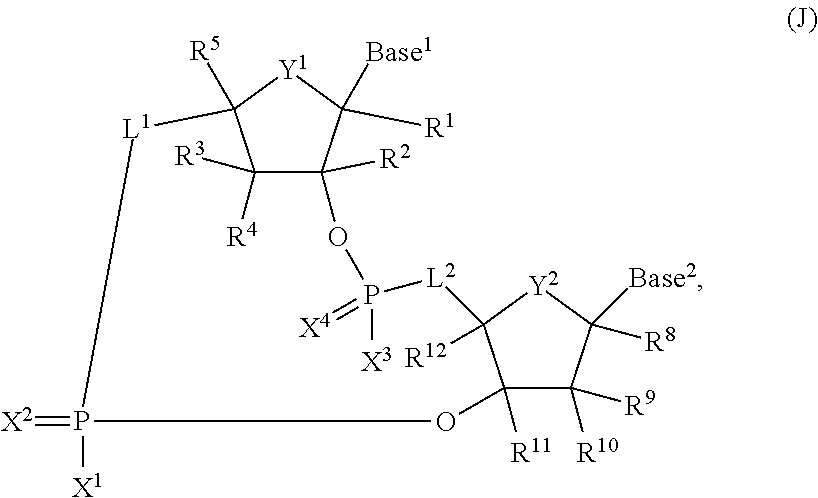2'3' cyclic dinucleotides with phosphonate bond activating the sting adaptor protein
- Summary
- Abstract
- Description
- Claims
- Application Information
AI Technical Summary
Benefits of technology
Problems solved by technology
Method used
Image
Examples
example 1
on of Monomers Derived from 4′-Phosphonomethoxy Nucleosides
[0899]
[0900]Compound 1 was prepared according to Kim, C. U., et al. (1991). Journal of Organic Chemistry 56(8): 2642-2647.
[0901]BzCN (2.6 g; 20 mmol) was added to a suspension of nucleoside 1 (1.6 g; 8 mmol) and Et3N (2.8 ml; 20 mmol) in DCM (80 ml), and the reaction mixture was stirred for 16 hours at room temperature. The reaction was quenched with 1 ml of MeOH and evaporated. The product (2) was isolated by chromatography on silica gel (0-3% EtOH in CHCl3, in the case of solutions, volume percentages are always stated) and lyophilized from dioxane to yield 2.3 g (90%): HRMS (M+Na)+ for C16H13O2N5Na calculated: 330.09615; measured: 330.09618; IR (CHCl3, cm−1): 3406, 3236, 1695, 1609, 1581, 1489, 1454, 1407, 1375, 1336, 1292, 1185, 1132, 1039, 1002, 926, 710, 646, 615; NMR: Table 1 and 2.
[0902]IBr (2.4 g, 12 mmol) dissolved in 50 ml DCM was added dropwise to a solution of nucleoside 2 (1.9 g, 6.0 mmol) and (iPrO)2P(O)CH2OH ...
example 2
of 4′-Phosphonomethoxynucleoside Diphosphates 20a, 20b and 20c
[0914]
Product 12
[0915]tert-Butyldimethylsilyl chloride (91 ml; 350 mmol) was added dropwise to a solution of L-ribose 11 (48 g; 320 mmol) in pyridine (700 ml) and the reaction mixture was stirred for 16 hours at room temperature. After L-ribose (11) vanished, Ac2O (122 ml; 1.28 mol) was added dropwise and reaction was stirred 16 hours at room temperature. The reaction was quenched with 100 ml of MeOH and concentrated, diluted with Et2O (500 ml) and extracted between Et2O (500 ml) and water (600 ml) followed by NaHCO3 (2×500 ml). The organic phase was dried over Na2SO4 and the product (2) was isolated by chromatography on silica gel (0-10% ethyl acetate in toluene) in a yield of 106 g (65%): HRMS (M+Na)+ for C27H34O8NaSi calculated: 537.19152; measured: 537.19154; IR (CHCl3, cm−1): 1751, 1589, 1488, 1473, 1464, 1390, 1370, 1220, 1178, 1075, 1028, 1010, 823, 703, 505; NMR: Table 3 and 4.
Product 13
[0916]Compound 13 was prepa...
example 3
of ((R,2R,3S,4R)-4-(6-oxo-1,6-dihydro-9H-purin-9-yl)-2,3-dihydroxycyclopentyl)methyl monohydrogen triphosphate trisodium salt (29a) and ((1R,2R,3S,4R)-4-(2-amino-6-oxo-1,6-dihydro-9H-purin-9-yl)-2,3-dihydroxycyclopentyl)methyl monohydrogen triphosphate trisodium salt (29b)
[0936]The syntheses of compounds 29a and 29b from compound 21 were accomplished according to the synthetic scheme depicted in Scheme 3 below, and detailed in the following description.
(1R,4S,5R,6S)-5,6-dihydroxy-2-azabicyclo[2.2.1]heptan-3-one (21)
[0937]To an ice-cold solution of (1R)-(−)-2-azabicyclo[2.2.1]hept-5-en-3-one (21.8 g, 0.2 mol) in dioxane (400 mL) was added 4-methylmorpholine N-oxide monohydrate (40.5 g, 0.3 mol) followed by slow addition of OsO4 (0.15 M soln in water, 2 mL). Slow dissolution of NMMO indicated reaction progress, reaction mixture was stirred for 1 h at 0° C. and 2 h at room temperature. Reaction was quenched by addition of sodium bisulfite (30% soln. in water, 5 mL), volatiles were evap...
PUM
| Property | Measurement | Unit |
|---|---|---|
| structure | aaaaa | aaaaa |
| pharmaceutical composition | aaaaa | aaaaa |
Abstract
Description
Claims
Application Information
 Login to View More
Login to View More - R&D
- Intellectual Property
- Life Sciences
- Materials
- Tech Scout
- Unparalleled Data Quality
- Higher Quality Content
- 60% Fewer Hallucinations
Browse by: Latest US Patents, China's latest patents, Technical Efficacy Thesaurus, Application Domain, Technology Topic, Popular Technical Reports.
© 2025 PatSnap. All rights reserved.Legal|Privacy policy|Modern Slavery Act Transparency Statement|Sitemap|About US| Contact US: help@patsnap.com



